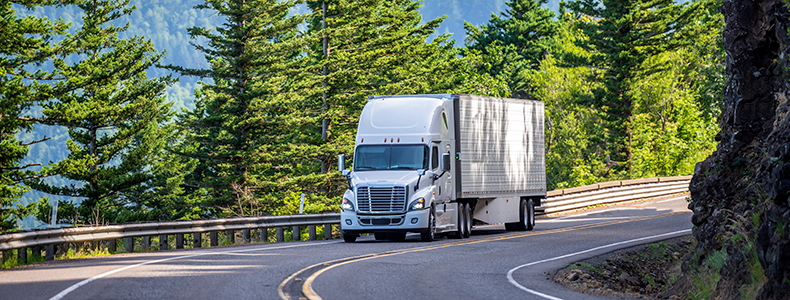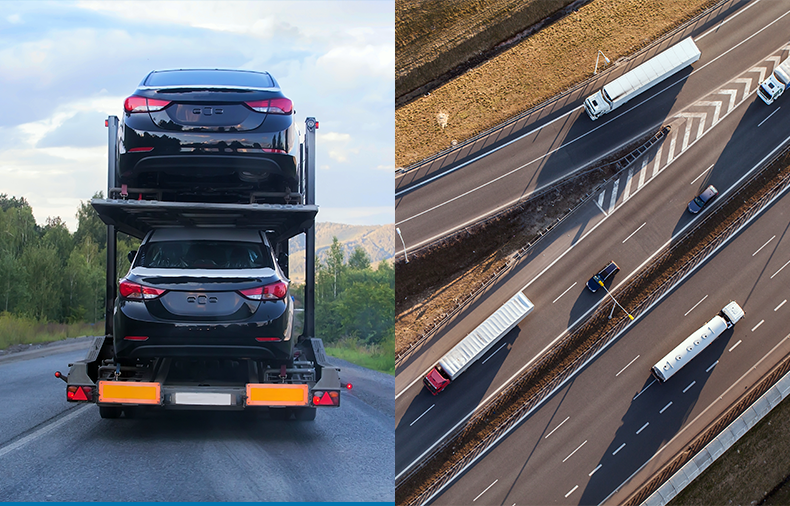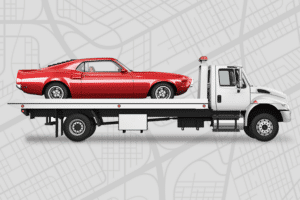Open vs enclosed vehicle shipping? Finding the right auto-shipping method for your needs can make all the difference. You want a smooth journey and peace of mind when getting your vehicle from point A to point B. As we know from experience, the shipping process contains unique decisions and logistics to figure out.
The good news is that today, there are more auto transportation options than ever — whether you need quick delivery, door-to-door service, or great value. The three main choices are open transport, enclosed auto transport, and specialty equipment shipping for oversized vehicles. Each has its pros and cons depending on cost, Timing, and desired protection from road elements.
Industry stats show more than 10 million vehicles are transported annually in the U.S. alone. So, plenty of us face these shipping considerations at some point. And making the optimal match between your priorities and the shipping method truly pays off. Fewer headaches, plus safe arrival, equals success!
Want to learn more about today’s top auto shipping options? Keep reading to discover how to choose what fits you best.
Understanding Open Shipping: An Efficient Option
Open shipping is a popular auto transport method that moves vehicles on uncovered trailers. This shipping style offers some advantages but also comes with tradeoffs to consider.
How Open Shipping Works
Open shipping is the most common and affordable auto transport method, moving vehicles on available, uncovered trailers that typically haul between 5 to 10 cars at once. This style allows faster overall transit times and flexibility in transporting to/from most locations in the U.S.
But the exposed nature also means reduced protection from weather and road debris, increasing potential risks of damage. Open shipping works best for standard, mass-produced vehicles when cost and quick timing are top priorities, and the destination doesn’t have extreme weather swings. For vehicle owners aligning with those needs, open transport does the job efficiently while remaining cost-conscious.
Safety Precautions with Open Shipping
While open carriers have inherent risks, reputable transport companies follow key protocols to protect vehicles in their care:
- Regular maintenance checks on straps/ties securing vehicles
- Adjusting ties as needed for shifting during transport
- Evaluating weather forecasts along routes
- Carrying essential protection equipment like a car cover
- Ensuring smooth accelerating/braking to minimize load shifting
- Securing loose vehicle parts that could detach
- Parking only in safe areas to minimize security issues
- Choosing routes that minimize risks as much as possible
The Key Benefits
Open shipping provides a few perks that make it an efficient choice for many vehicle owners:
- Cost Savings: Without enclosures, open shipping rates tend to be lower
- Availability: Broad supplier access across the U.S.
- Flexible Timing: Faster overall transit times
Remain Cautious on Drawbacks
However, the exposed nature of open carriers also comes with higher risks you’ll want to weigh:
- Reduced Protection: Vehicles face weather elements and road debris
- Potential Damage: Higher chance of wear-and-tear like paint chips, dirt
- Unsuitable for Certain Cars: Not ideal for delicate vehicles
Is Open Shipping Right for You?

Open transport works best for those shipping standard vehicles when:
- Cost is a top concern
- Quick transit time is preferred
- Destination doesn’t have extreme weather
If your priorities line up, open shipping gets the job done! Remember to inspect closely at delivery as you would with any shipping method.
Exploring Enclosed Auto Transport
When your vehicle means the world to you, minimizing any chance of damage during transport is a top priority. That’s where enclosed auto shipping offers clear value. This shipping method fully shelters cars from weather hazards and road debris. But this elite service comes at a premium price.
By definition, enclosed transport uses trailers or containers to transport vehicles door-to-door individually. Ensconced within protective shells, cars avoid risks like paint chips, dirt, and vandalism that open shipping may face.
Enclosed shipping suits owners of rare, exotic, vintage, and luxury vehicles invested in maintaining them in pristine condition. It also helps securely transport vehicles with aftermarket customizations or those loaded with extra accessories.
Premium Protection at a Cost
Transporting fewer vehicles per trailer (1-4 instead of 5-10) costs more per vehicle because there are fewer to share the price of the trailer and trip. Also, extra care and protection during the transport raises the price. Enclosed trailers that shield vehicles from weather and damage add more cost, too. Going through different weather on the way can also increase the price if special care is needed to prevent harm. For those extra services, enclosed delivery generally runs about 25-50% higher than open transport of more vehicles.
Open shipping will sufficiently get the job done for many basic transportation needs. But newer vehicles still under warranty, vintage collections, and supercar investments could benefit from enclosed carriers.
The Key Benefits of Enclosed Auto Transport
Opting for enclosed vehicle shipping provides several core advantages that protect vehicles end-to-end.
Total Shelter from External Hazards
- A fully enclosed metal shell prevents weather exposure
- Minimizes risks like rain/hail damage, dirt accumulation
- Stops road debris that may ding exterior paint
- Shields from falling branches, dust, and other hazards
All-Condition Reliability
Enclosed trailers deliver safe transit regardless of environment, thanks to containment features like:
- Temperature controls protect in extreme cold/hot
- Guards securing bottom clearance on ramps
- Suspension adjustments for snow or uneven terrain
Tamper & Theft Protection
- The enclosed design deters vandals while locked in transit
- Adds security stopping at hotels, gas stations
- Sensitive possessions are also less prone to pilfering
When to Choose Enclosed Shipping
While open shipping works for many vehicles, owners with cars in the below categories may want to consider enclosed transport:
High-Value & Rare Vehicles
- Classic/vintage: Protect irreplaceable vehicles
- Exotics: Preserve luxury car paint jobs
- Concept/custom: Shield one-off modifications
Protecting Delicate Conditions
- Show cars: Avoid exterior flaws
- Senior vehicles: Accommodate age needs
- Recent repairs: Shield fresh paint/bodywork
Cross-Country Hauls
- Northern snow to Southern humidity
- Dusty plains to coastal rainfall
- Mountain grades to flat highways
Special Circumstances
- Transporting extra accessories/loads
- Car collection moves
- Dealer inventory transfers
Although costlier, owners can quantify peace of mind. Enclosed shipping damage protection directly preserves asset value — whether that means rare Ferraris or aged family vehicles needing TLC.
Open Vs. Enclosed Shipping: Cost Comparison

The core tradeoff between open and enclosed vehicle transport involves cost. Enclosed options provide premium protection at an elevated price.
We want to ship a standard sedan 500 miles from New York City to Washington, DC. Using an open auto carrier, the estimated cost would be $500 (the average range is $500 – $1,000 for an empty page).
Using an enclosed trailer, the estimated cost would be $1,000. (Typically doubles the cost of open carrier). In this scenario, the enclosed transport costs $500 more than the open carrier:
- Open carrier cost: $500
- Enclosed carrier cost: $1,000
- Cost difference: $1,000 – $500 = $500 (100% more)
So, for this standard 500-mile shipment, enclosed shipping is 100% or twice as much as open shipping.
Now let’s say we are shipping a $75,000 luxury sports car the exact 500 miles:
- Open carrier cost: $500
- Enclosed carrier cost: $1,000
- Cost difference: $1,000 – $500 = $500 (100% more)
Even though the vehicle is high-end, the cost difference remains 100% higher for enclosed transport over open. The extra $500 charge may be worth it for valuable cars needing additional transit protection. However, the proportional relationship in pricing holds.
Critical Reasons for Pricing Difference
Enclosed auto transport trailers carry fewer vehicles per transit than open carriers, typically just 1-4 cars versus 5-10 with empty trailers. The specialized equipment and trailer materials also lead to higher operating expenses. This includes costs for customized enclosed trailers, ramps, straps, protective gear, and other handling equipment needed to transport more valuable vehicles safely.
- Drivers must take more individualized handling and special precautions for the lower vehicle volume in enclosed trailers.
- Attentiveness is also critical across longer transport distances to provide white glove service.
- The lower supply of enclosed shipping capabilities and high demand for exotic car transport also lead to increased pricing.
The increased cost mirrors the elevated care. So, while open shipping fits most regular transports, owners weigh if enclosed value protection merits the pricing premium.
Choosing Between Open or Enclosed Auto Transport: Key Factors
While open carriers are more common, enclosed trailers provide extra protection. Understanding the core differences can help determine what option best suits your needs and priorities. Here are the top factors to weigh when picking open versus enclosed shipping for your vehicle:
- Vehicle Type & Value: High-end vehicle categories like exotics, vintage classics, and luxury cars often warrant enclosed shipping to protect their condition, collectability, and monetary worth during transit. Everyday consumer vehicles can typically economize by using standard open carriers.
- Transport Distance & Route Considerations: Cross-country transport exposes vehicles to vastly different geography and weather from start to finish. Multi-climate trips with exposure to snow, rain, salt, and elevation changes present higher damage risks, favoring enclosed shipping. Shorter in-state moves are generally acceptable on open carriers when environmental conditions are more consistent.
- Existing Wear & Standards: Owners of mint condition vehicles rightfully call for enclosed shipping care around road debris, winter salts, and weather extremes to uphold pristine status. Those less particular about small exterior flaws like minor chips can save money with open shipping. Your standards determine needs.
- Special Modifications & Custom Upgrades: Heavily customized vehicles, especially those with unique body kit fabrications, often choose enclosed shipping to better secure aftermarket equipment against road vibrations. However, enclosed and open carriers can safely transport the most common “bolt-on” add-ons like spoilers, mufflers, trim pieces, and basic electronics.
- Flexible Timing Needs: Enclosed shipping offers more flexible pickup timing and door-to-door vehicle handling – a plus for owners on tight schedules or needing customs coordination. Open carriers transport in scheduled group lots on set departure dates to maximize efficiency. Timing importance helps determine the best method.
- Budget Considerations: For most general consumer vehicles, 25-50% or more open shipping savings outweigh relatively minimal condition risks for owners. But specialized classics, vintage cars, and high-value exotics merit spending extra for enclosed shipping protection to preserve assets. Budget priority balances against protection needs.
Customer priorities speak volumes through real shipping scenarios. Protecting valuable assets and special equipment echoes the loudest calling for enclosed shipping services. When vehicles mean so much, only the ultimate care suffices.
Frequently Asked Questions (FAQs)
When does enclosed shipping make sense for my car?
Enclosed trailers are best for vintage collector vehicles, exotic luxury/sports cars, valuable custom rides, and celebrity/racecars needing discreet white glove service. Condition and value warrant paying extra for protection.
What are the most significant advantages of enclosed shipping?
Enclosed trailers provide maximum loss/damage prevention through complete vehicle isolation during transport. The car remains secured from weather, road debris that could dent/chip paint, and temptation or unauthorized access.
How difficult is loading/unloading with enclosed carriers?
Enclosed trailers require extra coordination, like scheduling ramp trucks for vehicle access. Loading/unloading takes more time and care. Open carriers offer easier direct vehicle access by comparison.
Does enclosed or open shipping take less time for cross-country transport?
Open carriers with more vehicles tend to transit long distances faster than enclosed rigs carrying fewer cars. Extra precautions with enclosed trailers translate to slower speeds down the road. The transit time also depends on many additional factors in both cases, though.
Does vehicle condition/operability affect pricing differently?
Yes, inoperable or damaged vehicles often cost more for open transport needing unique equipment/mechanics. Enclosed prices remain consistent but cater more to working collector classics and exotics than Junkers.
What type of insurance is included? Does enclosed have higher insurance rates?
Both open and enclosed carriers must be insured in case of damages/loss. Enclosed trailers often carry higher overall policy limits due to the higher-value cargo being transported. The premium costs get calculated into the higher pricing.
Can I accompany my vehicle inside an enclosed trailer?
In most cases, passengers cannot ride inside enclosed trailers with vehicles during transit due to safety/liability reasons and limited space. Some high-end exotic services occasionally offer special ride-alongs, but open carriers with several vehicles give better ride options if you wish to trail your car personally.
What restrictions apply for modified/customized cars and bikes?
Remarkably lowered/lifted vehicles or wildly customized builds often have trouble safely clearing loading ramps into trailers. Make sure to disclose all unique modifications to determine any special equipment needs before transport booking. Disclosure assures proper fit.
Do I need to prepare my car before transporting it on the open trailer?
The best practice is removing looser exterior parts like antennas before open transit to prevent ripping off at speed. Other preparations, like disabling alarms, topping off fluids, and documenting cosmetic conditions beforehand, bring added precaution. Follow carrier guidance. Enclosed prep is minimal by comparison.
Making the Right Choice
Deciding between open or enclosed car shipping involves weighing several vital factors. At the core, it’s a choice between cost and protection. Available carriers offer more affordable transportation, while enclosed trailers provide maximum security.
If shipping a standard personal vehicle, an open carrier likely makes the most sense. Available trailers can transport vehicles long distances rather quickly and cheaply. They furnish reasonable protection from road hazards like stones, though cars are still exposed to weather elements. This efficient transport works for typical ground shipping needs.
However, for rare, exotic, or high-value vehicles, owners tend to prefer enclosed shipping. Despite costing around 50% more, enclosed trailers supply premium handling and loss prevention.
Cars ride sheltered from unfavorable weather and road debris that could tarnish appearance and value. Enclosed shipping guarantees vehicles remain temptation-free and trouble-free.
So, assess your specific transportation needs. How much protection does your vehicle demand? What is your budget flexibility? Crunching numbers helps guide prudent decisions. Open carriers offer savings for essential ground transport.
Enclosed trailers provide peace of mind for cherished vehicles requiring white glove service. Weigh cost versus security to make the ideal choice, granting confidence in every shipment you send.



